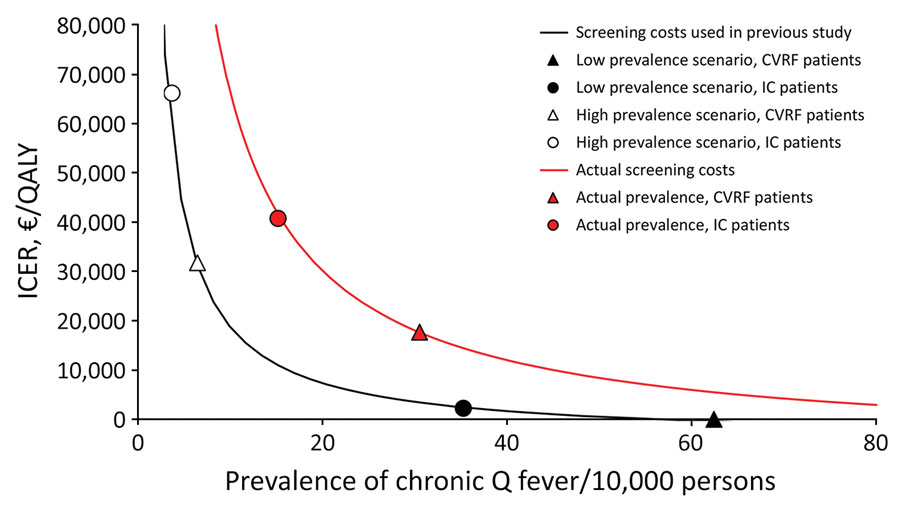Volume 28, Number 7—July 2022
Research
Targeted Screening for Chronic Q Fever, the Netherlands
Figure 2

Figure 2. Relationship between the prevalence of chronic Q fever and incremental cost-effectiveness ratio of a screening program to detect chronic Q fever, the Netherlands, and screening costs for the program compared with a previously published analysis (7). Symbols on the line are based on a high-prevalence and low prevalence rate scenario as used in the previously published analysis and are based on actual prevalence rates found in this study. CVRF, cardiovascular risk factor; IC, immunocompromised; ICER, incremental cost-effectiveness ratio; QALY, quality-adjusted life year.
References
- van Roeden SE, Wever PC, Kampschreur LM, Gruteke P, van der Hoek W, Hoepelman AIM, et al. Chronic Q fever-related complications and mortality: data from a nationwide cohort. Clin Microbiol Infect. 2019;25:1390–8. DOIPubMedGoogle Scholar
- van der Hoek W, Hogema BM, Dijkstra F, Rietveld A, Wijkmans CJ, Schneeberger PM, et al. Relation between Q fever notifications and Coxiella burnetii infections during the 2009 outbreak in The Netherlands. Euro Surveill. 2012;17:20058. DOIPubMedGoogle Scholar
- Wever PC, Arts CH, Groot CA, Lestrade PJ, Koning OH, Renders NH. [Screening for chronic Q fever in symptomatic patients with an aortic aneurysm or prosthesis] [in Dutch]. Ned Tijdschr Geneeskd. 2010;154:A2122.PubMedGoogle Scholar
- Kampschreur LM, Oosterheert JJ, Hoepelman AI, Lestrade PJ, Renders NH, Elsman P, et al. Prevalence of chronic Q fever in patients with a history of cardiac valve surgery in an area where Coxiella burnetii is epidemic. Clin Vaccine Immunol. 2012;19:1165–9. DOIPubMedGoogle Scholar
- Hagenaars JC, Wever PC, van Petersen AS, Lestrade PJ, de Jager-Leclercq MG, Hermans MH, et al. Estimated prevalence of chronic Q fever among Coxiella burnetii seropositive patients with an abdominal aortic/iliac aneurysm or aorto-iliac reconstruction after a large Dutch Q fever outbreak. J Infect. 2014;69:154–60. DOIPubMedGoogle Scholar
- de Lange MMA, Scheepmaker A, van der Hoek W, Leclercq M, Schneeberger PM. Risk of chronic Q fever in patients with cardiac valvulopathy, seven years after a large epidemic in the Netherlands. PLoS One. 2019;14:
e0221247 . DOIPubMedGoogle Scholar - de Boer PT, de Lange MMA, Wielders CCH, Dijkstra F, van Roeden SE, Bleeker-Rovers CP, et al. Cost-effectiveness of screening program for chronic Q fever, the Netherlands. Emerg Infect Dis. 2020;26:238–46. DOIPubMedGoogle Scholar
- Wegdam-Blans MC, Kampschreur LM, Delsing CE, Bleeker-Rovers CP, Sprong T, van Kasteren ME, et al.; Dutch Q fever Consensus Group. Chronic Q fever: review of the literature and a proposal of new diagnostic criteria. J Infect. 2012;64:247–59. DOIPubMedGoogle Scholar
- Melenotte C, Gay L, Mezouar S, Bardin N, Raoult D, Mège JL. The sexual dimorphism of anticardiolipin autoantibodies in acute Q fever patients. Clin Microbiol Infect. 2019;25:763.e1–3. DOIPubMedGoogle Scholar
- Melenotte C, Protopopescu C, Million M, Edouard S, Carrieri MP, Eldin C, et al. Clinical features and complications of Coxiella burnetii infections from the French National Reference Center for Q fever. JAMA Netw Open. 2018;1:
e181580 . DOIPubMedGoogle Scholar - Pijnacker R, Reimerink J, Smit LAM, van Gageldonk-Lafeber AB, Zock J-P, Borlée F, et al. Remarkable spatial variation in the seroprevalence of Coxiella burnetii after a large Q fever epidemic. BMC Infect Dis. 2017;17:725. DOIPubMedGoogle Scholar
- Buijs SB, van Roeden SE, van Werkhoven CH, Hoepelman AIM, Wever PC, Bleeker-Rovers CP, et al. The prognostic value of serological titres for clinical outcomes during treatment and follow-up of patients with chronic Q fever. Clin Microbiol Infect. 2021;27:1273–8. DOIPubMedGoogle Scholar
- Buijs SB, Bleeker-Rovers CP, van Roeden SE, Kampschreur LM, Hoepelman AIM, Wever PC, et al. Still new chronic Q fever cases diagnosed eight years after a large Q fever outbreak. Clin Infect Dis. 2021;73:1476–83. DOIPubMedGoogle Scholar
- National Institute for Public Health and the Environment. Advisory letter for detection of chronic Q fever patients, 2021 [in Dutch] [cited 2021 Oct 1]. https://www.rijksoverheid.nl/documenten/publicaties/2021/09/15/adviesbrief-opsporing-chronische-q-koortspatienten
Page created: May 06, 2022
Page updated: June 18, 2022
Page reviewed: June 18, 2022
The conclusions, findings, and opinions expressed by authors contributing to this journal do not necessarily reflect the official position of the U.S. Department of Health and Human Services, the Public Health Service, the Centers for Disease Control and Prevention, or the authors' affiliated institutions. Use of trade names is for identification only and does not imply endorsement by any of the groups named above.